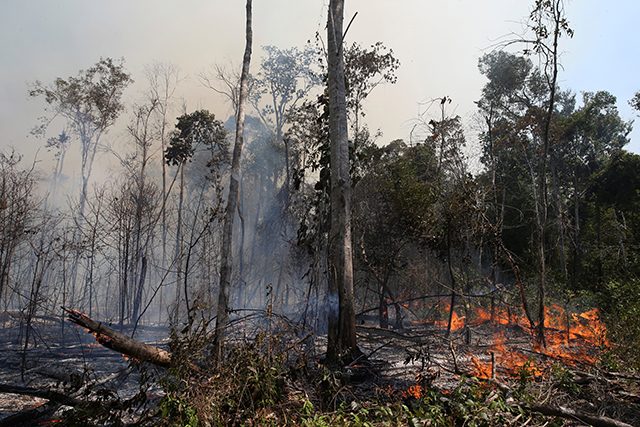
TENHARIM TERRITORY, Brazil — The vice-chief of the village of Pakyri knows that next year his people will face hard times, as the fires raging in the Amazon forest burn their food, medicine and livelihoods.
Deusdimar Tenharim estimates that about 60,000 hectares of the protected land where his people hunt and gather has been burned during the fires – and the blazes are not out yet.
“Our firemen are not being able to handle it … the trees where we pick Brazil nuts are gone,” he said.
The vice-chief explained that the nuts are sold in nearby towns, and used for rituals and medicine.
“They are sacred to us, and we already know that next year, 2020, it will be harder to find them in the jungle,” he said.
Last month, Brazil’s space research agency, INPE, announced that the number of fires in the Amazon was the highest since 2010.
That sparked international calls for the country to do more to protect the world’s largest tropical rainforest from deforestation and other threats.
The forest is considered key to holding the line on global climate change, and the evaporation it produces drives rainfall crucial for agriculture across a broad swathe of South America, scientists say.
The Tenharim indigenous territory lies between two medium-sized towns in Amazonas state, and occupies a total of 1.8 million hectares. It is home to several Amazonian tribes.
Deusdimar, of Pakyri, said he has no doubt the fires his tribe is facing are man-made.
Trained as a firefighter himself, he said it is clear when a fire is natural, judging in part by where it starts – and these fires are not natural in his view.
“This is all due to ambition,” he said. Farmers are burning forest to open up farmland and “we are hurt directly and indirectly”.
Brazil nuts are not the only resource going up in smoke either.
A local healer, Raimundinha Tenharim, worries she won’t be able to find the herbs and roots she uses when her people get sick – and they have few other options for medical treatment.
Families living in the dozen vilages in the Tenharim reserve have little means of road transport to urban centers, beyond the buses that pass once a day on the nearest highway.
That means most medical issues are treated with local medicines, using herbs taken from the forest. But that forest is now on fire, Raimundinha said.
Since the blazes started, she has relied on her stockpiles of natural medicines to treat ailments, including smoke inhalation among indigenous children.
In the forest, “I have medicine for cough, medicine for wounds, for everything,” she said. “I don’t know what I would do without them.”
Fighting fire with fire
The current fires in Tenharim territory are not the first this year, but they are the first set by people other than the indigenous residents themselves.
Some members of the Tenharim tribe work as firefighters for Ibama, the national environment agency.
This year they for the first time lit fires in parts of their forest in May and June in an effort to control fire risks during the coming dry season.
The controlled fires created cleared areas around a few key pieces of forest, home to animals and forest foods crucial to the tribe, they said.
The cleared areas have helped prevent the fire situation from being completely out of control this year, the firefighters said.
“If we had not done this, the fires would have been be so much worse,” one told Thomson Reuters Foundation.
Both asked not be identified because they were not allowed to speak to the press.
But they said the areas protected from the blazes were fairly limited, as this was the first year the community had tried the technique.
Currently, almost 30 indigenous firefighters are helping fight wildfires in the region, working mainly at night.
“You can’t fight the fire during the day. It’s too windy,” one said.
Song for the fallen forest
Along the Trans-Amazonian Highway, the 4,000-kilometer-long (2,500 mile) road that passes through seven Brazilan states, signs of the fires that burned farms and forest near the Tenharim territory are still visible.
Indigenous residents said they blame Jair Bolsonaro, Brazil’s right-wing president, for undermining the country’s environmental agency.
Since Bolsonaro took office, Ibama’s budget has shrunk by a quarter as part of government-wide belt tightening, according to internal government data collected by the opposition Socialism and Liberty (PSOL) party and shared with Reuters.
Among the cuts were funding for prevention and control of forest fires, which saw a budget reduction of 23%, the data showed.
After an international backlash over this year’s runaway fires, Bolsonaro authorized the military to fight fires in the Amazon, and since last week the blazes have receded.
On the stretch of Trans-Amazonian Highway that passes through Tenharim territory, military vehicles and trucks carrying fuel for planes that drop water on the fires have become a common sight.
Marcio Tenharim, a representative for the indigenous territory’s tribes, said he hopes the world will learn about the damage his people are suffering.
After that, he said, there will be nothing left to do but mourn.
“We will have a ritual. We will sing in mourning for the fires,” he said.—Reporting by Fabio Teixeira ; editing by Laurie Goering, the Thomson Reuters Foundation








